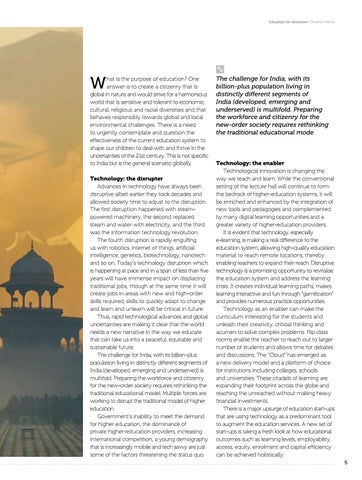Education for tomorrow | Shobha Mishra
W
hat is the purpose of education? One answer is to create a citizenry that is global in nature and would strive for a harmonious world that is sensitive and tolerant to economic, cultural, religious and racial diversities and that behaves responsibly towards global and local environmental challenges. There is a need to urgently contemplate and question the effectiveness of the current education system to shape our children to deal with and thrive in the uncertainties of the 21st century. This is not specific to India but is the general scenario globally. Technology: the disrupter Advances in technology have always been disruptive albeit earlier they took decades and allowed society time to adjust to the disruption. The first disruption happened with steampowered machinery, the second replaced steam and water with electricity, and the third was the information technology revolution. The fourth disruption is rapidly engulfing us with robotics, internet of things, artificial intelligence, genetics, biotechnology, nanotech and so on. Today’s technology disruption which is happening at pace and in a span of less than five years will have immense impact on displacing traditional jobs, though at the same time it will create jobs in areas with new and high-order skills required, skills to quickly adapt to change and learn and unlearn will be critical in future. Thus, rapid technological advances and global uncertainties are making it clear that the world needs a new narrative in the way we educate that can take us into a peaceful, equitable and sustainable future. The challenge for India, with its billion-plus population living in distinctly different segments of India (developed, emerging and underserved) is multifold. Preparing the workforce and citizenry for the new-order society requires rethinking the traditional educational model. Multiple forces are working to disrupt the traditional model of higher education. Government’s inability to meet the demand for higher education, the dominance of private higher-education providers, increasing international competition, a young demography that is increasingly mobile and tech savvy are just some of the factors threatening the status quo.
The challenge for India, with its billion-plus population living in distinctly different segments of India (developed, emerging and underserved) is multifold. Preparing the workforce and citizenry for the new-order society requires rethinking the traditional educational mode
Technology: the enabler Technological innovation is changing the way we teach and learn. While the conventional setting of the lecture hall will continue to form the bedrock of higher-education systems, it will be enriched and enhanced by the integration of new tools and pedagogies and complemented by many digital learning opportunities and a greater variety of higher-education providers. It is evident that technology, especially e-learning, is making a real difference to the education system, allowing high-quality education material to reach remote locations, thereby enabling teachers to expand their reach. Disruptive technology is a promising opportunity to revitalise the education system and address the learning crisis. It creates individual learning paths, makes learning interactive and fun through “gamification” and provides numerous practice opportunities. Technology as an enabler can make the curriculum interesting for the students and unleash their creativity, critical thinking and acumen to solve complex problems. Flip class rooms enable the teacher to reach out to larger number of students and allows time for debates and discussions. The “Cloud” has emerged as a new delivery model and a platform of choice for institutions including colleges, schools and universities. These citadels of learning are expanding their footprint across the globe and reaching the unreached without making heavy financial investments. There is a major upsurge of education start-ups that are using technology as a predominant tool to augment the education services. A new set of start-ups is taking a fresh look at how educational outcomes such as learning levels, employability, access, equity, enrolment and capital efficiency can be achieved holistically. 5
